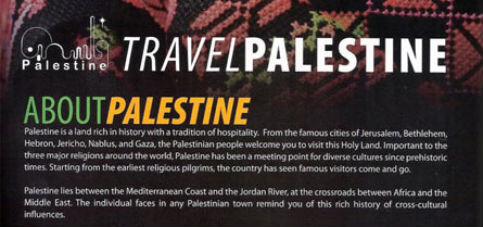The Electronic Intifada 5 February 2011

A detail of the Palestinian Ministry of Tourism ad
This holiday season, an advertisement from the Palestinian Ministry of Tourism was attacked for “ignoring” Israel’s existence. The charges of geographical misrepresentation stem from the following lines:
“From the famous cities of Jerusalem, Bethlehem, Hebron, Jericho, Nablus, and Gaza, the Palestinian people welcome you to visit this Holy Land … Palestine lies between the Mediterranean Coast and the Jordan River, at the crossroads between Africa and the Middle East.”
The ad, which ran in National Geographic’s Traveller magazine, resulted in more than sixty complaints being lodged with the UK’s Advertising Standards Authority (ASA) and is now under investigation. As the UK’s Guardian newspaper reported, London lawyer David Lewis wrote a letter to the ASA complaining that “it implies that ‘Palestine’ has a Mediterranean coastline; but while this is true as regards to Gaza, that territory is not within the de facto jurisdiction of the Palestinian Authority. More seriously, it implies that Palestine occupies the whole or the bulk of the territory between the Mediterranean and the Jordan, ignoring the existence of Israel.” Other commentators objected to the inclusion of Jerusalem as a Palestinian city (“Palestinian holiday ad ‘ignored existence of Israel’,” 10 January 2011).
Last year, two Israeli tourism ads were banned by the ASA for including landmarks from disputed territories, such as the Dome of the Rock. But if the same standards are applied to Palestine — if Palestine is forbidden to include “disputed” territories — then Palestine has little or nothing to advertise. Even the fraction of Palestine under what could be considered “Palestinian control” is under de facto Israeli control due to the occupation, settlements and Israel’s wall in the West Bank. According to Ben White’s Israeli Apartheid, in 2000, only 17 percent of the West Bank was under “full Palestinian control,” and increasing settlement construction over the last decade means there is even less land under such control today. Moreover, the idea of “full Palestinian control” is a delusion, as Palestinians do not have control over the airspace or the population registry, nor do they have the ability to cross boundaries within the occupied territories at will.
By Lewis’s definition, in which only areas under “full Palestinian control” can be considered Palestine, there is no Palestinian land that the Ministry of Tourism can promote. This makes the current trappings of Palestinian statehood, such as the Palestinian Ministry of Tourism, a sham. To “concede” cultural organizations to the Palestinian people as evidence of granting them some degree of self-rule is an empty gesture when they are denied their own territory from which to act as cultural and political authorities. To deny the whole of the West Bank and Gaza to the Palestinian Ministry of Tourism is to deny them to the Palestinian Authority, or any other puppet-government-institution granted to the Palestinians. If the PA is not in control of the occupied territories — and this is the case — how can it be expected to govern the Palestinian people, or negotiate with Israel on equal terms?
The disparity is especially jarring considering that the Government of Israel’s tourism website (www.goisrael.com) does not mention Palestine under the “State of Israel” section or even the “Muslims in Israel” section. When giving a virtual tour, a map pops up in which the West Bank and Gaza Strip are in a slightly different shade but appear to be part of Israel, and the cities of Hebron, Bethlehem and Nablus are highlighted in large letters. There is nothing to indicate that the occupied West Bank and Gaza Strip, or these cities in particular, do not belong to Israel. The map does not include the names of cities in bordering countries, emphasizing the illusion that Hebron and the others are part of Israel. The boundaries of Israel do not curve inside the West Bank and Gaza, or even follow the line of the wall, which cuts deep into the West Bank, but include the occupied territories completely.
This map is, sadly for Palestinians, less a distortion than an accurate representation of reality in which Israel is the de facto — if not de jure — owner of the entire mass of land, controlled through military occupation, unequal access to natural resources, denial of building permits to Palestinians and limitations on the movements of Palestinians through checkpoints and roadblocks.
The map is also fitting, given that while Palestinians are constantly called upon to recognize Israel as a preexisting condition to any negotiations, Israelis are not expected, prior to negotiations, to recognize Palestine. The Palestinian advertisement was lambasted for its “rejectionism” by the Board of Deputies of British Jews since it did not mention Israel, but the “rejectionist” label should then be applied to the Israeli Ministry of Tourism. (Not to mention the BBC Series Top Gear for the episode in which the stars drove to the Palestinian town of Bethlehem without mentioning “Palestine” or “Palestinians” even once.)
Perhaps a more accurate piece could have run as follows: “Palestine stretches from the Gaza Strip on the Mediterranean Sea to the West Bank on the Jordan River, with the State of Israel in between. However, a wall that is illegal under international law cuts off a large section of the West Bank, and most of the land that is now called Palestine is actually under Israeli military rule. We invite you to East Jerusalem, which is being illegally annexed by Israel. We invite you to Hebron, Bethlehem and Nablus, but please only attempt to travel between these West Bank cities if you are not of Palestinian descent (and preferably not ethnically Arab), as you could be held for hours at checkpoints or denied entry. We should also point out, if we are to represent the land of Palestine honestly, that much of the West Bank is overtaken with Israeli settlements, also considered illegal under international law. You are also invited — as long as you aren’t a Palestinian — to see the tourist sites in nearby Israel, which was ethnically cleansed during its 1948 founding.”
This formulation is clearer, and it mentions Israel. One wonders if Mr. Lewis would object.
Paula Rosine Long is a poet and activist from North Carolina. She is currently a graduate student at Cambridge University in Middle Eastern Studies and is writing her thesis on Edward Said’s role in Palestinian collective memory.



